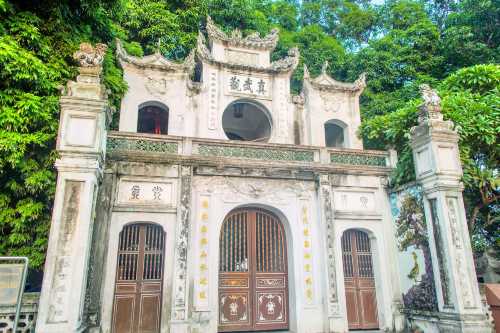Quan Thanh Temple: A Historical and Cultural Gem of Hanoi Overview Quan Thanh Temple (Đền Quán Thánh), also known as Tran Vu Temple, is one of Hanoi's oldest and most sacred Taoist temples. Established in the 11th century during the Ly Dynasty, it is part of the "Four Sacred Temples of Thang Long Citadel," guarding the northern entrance of the ancient capital. The temple is dedicated to Huyen Thien Tran Vu (Xuan Wu), the Taoist deity of the north, symbolized by a serpent and turtle. Located near West Lake at the intersection of Quan Thanh and Thanh Nien Streets, it remains a key spiritual and tourist site in Hanoi. Historical Significance - Founding: Built in 1010 under Emperor Ly Thai To to celebrate the relocation of Vietnam’s capital to Thang Long (modern Hanoi). - Sacred Role: One of four temples (alongside Bach Ma, Kim Lien, and Voi Phuc) positioned to protect the city from malevolent spirits and invaders. - Renovations: Restored multiple times, most notably in 1677 (when the iconic bronze statue was added) and 1893, blending Ly, Le, and Nguyen Dynasty architectural styles. Architecctural Highlights 1. Bronze Statue of Tran Vu: - Cast in 1677 by artisans from Ngũ Xã village, this 3.96-meter-tall, 3.6-ton black bronze statue depicts Tran Vu seated on a turtle, wielding a sword entwined by a serpent. It is Vietnam’s second-largest bronze statue and a masterpiece of 17th-century craftsmanship. - The deity’s symbols—the turtle (protection) and serpent (wealth)—reflect Taoist and Vietnamese folklore traditions. 2. Structural Features: - Three-Gate Entrance: Adorned with phoenixes and unicorns, typical of Nguyen Dynasty design. - Courtyard: Shaded by a centuries-old banyan tree, with a brick oven for burning joss paper during festivals. - Ancient Artifacts: Includes a 1.15-meter bronze bell, wood carvings of mythical creatures, and over 60 parallel poems in Chinese characters. Cultural and Spiritual Practices - Festivals: Locals visit during Tet (Lunar New Year) and on the 1st/15th lunar month days to pray for health, luck, and prosperity. - Syncretism: Though Taoist, the temple integrates Buddhist and Confucian elements, reflecting Vietnam’s religious blending. - Martial Arts: Hosts Vovinam classes, honoring Tran Vu’s association with martial prowess. Visitor Information - Location: 190 Quan Thanh Street, Ba Dinh District. - Hours: - Daily: 8:00 AM – 5:00 PM. - Extended hours on Tet Eve and lunar month days (6:00 AM – 8:00 PM). - Entry Fee: 10,000 VND (adults); 5,000 VND (students/children). - Dress Code: Modest attire covering shoulders and knees. Best Time to Visit: Early morning for tranquility, or during Tet (January–February) for vibrant rituals. Nearby Attractions 1. Tran Quoc Pagoda: Vietnam’s oldest pagoda, located on West Lake. 2. Ho Chi Minh Mausoleum: 1 km away, housing the embalmed leader. 3. Temple of Literature: Vietnam’s first university, dedicated to Confucius. Conclusion Quan Thanh Temple is a testament to Hanoi’s rich spiritual heritage and architectural ingenuity. Its iconic bronze statue, serene ambiance, and historical depth make it a must-visit for those exploring Vietnam’s cultural legacy. Whether admiring its artistry or participating in age-old rituals, the temple offers a profound glimpse into the soul of Hanoi. #travel #vietnam #hanoi #temple
Ice Lim 33
Popular Trip Moments
Nature Near Hanoi🌲 Ba Vi National park 🇻🇳 | Salmonoid - a hidden gem in Hanoi | Presidential Palace | [Hanoi/Gourmet] A Vietnamese restaurant with a local feel | Cultural Integration and Historical Structure—Turtle Tower | Cozy Hanoi Spots🏠 | Dolce by Wyndham Hanoi Golden Lake | Hoan Kiem Lake — The Scenery of Vietnamese Beauties | SalutePremiumHotel&SpaHanoi Review | Hanoi's Hidden Easter Egg: Venice-Style Water City Zero-Cost Check-In Guide! | Hanoi is a fascinating and worth visiting again and again | [Hanoi/Cafe] A cute cafe with terrace seats | Check in at the incense-making village in Hanoi, Vietnam with National Geographic | 🧺 UNIQLO Hoan Kiem (Hanoi) | Ho Chi Minh's Former Residence in Hanoi | Hochiminh's stilt house | Ho Chi Minh Mausoleum | 🏠 Heritage Corner Hostel Hanoi – ที่พักเล็ก ๆ กลา | A must-see in Hanoi! The Temple of Literature, a Confucian temple in Hanoi. | A must-see in Hanoi! Ti Top Island in Ha Long Bay, offering panoramic views of Ha Long Bay. | Hanoi is LOVE 🫶 | The essence of Vietnamese study abroad: the Great Hall of the Temple of Literature in Hanoi | A symbol of the Vietnamese independence movement, the Hoa Lo Prison Museum in Hanoi | A must-see in Hanoi! St. Joseph's Cathedral, a stunning neo-Gothic building. | Explore the charm of Hanoi, the ancient capital of Vietnam #HanoiCityTour-Hanoi, Vietnam | [Hanoi/Cafe] A cafe popular with local girls | Visit the original Cong Cafe in the land of coconuts! Cong Cafe at St. Joseph's Cathedral in Hanoi, Nha Tho
Recommended Attractions at Popular Destinations
Popular Attractions in Bangkok | Popular Attractions in Kuala Lumpur | Popular Attractions in Dubai | Popular Attractions in Chefchaouene | Popular Attractions in Kyoto | Popular Attractions in Los Angeles | Popular Attractions in Bali | Popular Attractions in Shanghai | Popular Attractions in Iguazu National Park(Argentina) | Popular Attractions in New York | Popular Attractions in Paris | Popular Attractions in Walt Disney World Resort | Popular Attractions in Melbourne | Popular Attractions in London | Popular Attractions in Singapore | Popular Attractions in Beijing | Popular Attractions in Las Vegas | Popular Attractions in Rome | Popular Attractions in Zanzibar Island | Popular Attractions in Sydney | Popular Attractions in West Lake | Popular Attractions in Osaka | Popular Attractions in Tokyo | Popular Attractions in Phuket | Popular Attractions in Barcelona | Popular Attractions in Madrid | Popular Attractions in Chengdu | Popular Attractions in Florence | Popular Attractions in Istanbul | Popular Attractions in Jungfrau Region
Popular Attractions
Jiaoshan Mountain | Zhanqiao Park | Little Qingdao | Lu Xun Park | Zhongshan Park | Quyuanfenghe (Breeze-Rustled Lotus In Quyuan Garden) | Huashilou House | LaoLong Jing Yu ChaYuan | Dai Temple | Queen Mother Pond | Baoshi Liuxia | Nantian Gate | Azure Cloud Temple | Dongpo Academy | Songtao Reservoir | Yunnan Nationalities Village | Manfeilong Pagoda | Xishuangbanna Dai Garden | Halte riveraine municipale | Wat Si Kak Ratbamrung | Vitthal Mandir | Masjid Al-Istiqomah | Simi Hills Neighborhood Park | Parc de la Bergerie | Amfiteatr W Gorzowie Śląski | Wapley Bushes | Concejal Jose Antonio Pérez Henarejos Park | Pu Zhao Temple | Eighteen Twistings
Popular Restaurants in Hanoi
Cau Go Restaurant | ERA RESTAURANT | Highway4 Bar Restaurant | Pho Ga Nguyet | Pho 10 Ly Quoc Su | Tầm vị | Essence Restaurant | Quan An Ngon | Old Hanoi Restaurant | LE BEAULIEU | Phở Bò Ấu Triệu | Chè 4 Mùa Hàng Cân | Cha Ca Thang Long | Maison Sen | La Badiane | Bun Cha Dac Kim | HOME Vietnamese Restaurant | Bun Cha Huong Lien | Tiem Com Mot Ngay Moi New Day Restaurant | Nhà hàng 1946 Cửa Bắc | Oc Nong Ha Trang | Hanoi Food Culture | Nhà hàng 1946 Cửa Bắc | The Hudson Rooms | Banh Mi 25 | French Grill | Pho Thin Bo Ho | The Gourmet Corner | Hemispheres Steak & Seafood Grill | Cloud Nine Restaurant
Popular Ranked Lists
Top 50 Must-Visit Restaurants in Sapporo | Top 50 Best Things to Do in Prague | Top 50 Must-Visit Restaurants in Chengdu | Top 50 Must-Visit Restaurants in Chongqing | Top 50 Must-Visit Restaurants in Paris | Top 20 Best Things to Do in George Town | Top 50 Must-Visit Restaurants in Beijing | Top 50 Best Things to Do in Paris | Top 50 Must-Visit Restaurants in Hanoi | Top 50 Best Things to Do in Barcelona | Top 50 Best Things to Do in Madrid | Top 50 Must-Visit Restaurants in Jeju | Popular Luxury Hotels Near Cartagena | Top 50 Best Things to Do in Sydney | Top 10 Luxury Hotels near Naperville | Top 50 Luxury Hotels near Mandelieu La Napoule | Popular Luxury Hotels in Gampaha | Top 20 Luxury Hotels near Bochum | Top 50 Must-Visit Restaurants in Ho Chi Minh City | Top 50 Must-Visit Restaurants in Santorini | Popular Premium Hotels Near Lipetsk | Top 50 Best Things to Do in Istanbul | Top 50 Must-Visit Restaurants in Fukuoka | Top 50 Must-Visit Restaurants in Washington D.C. | Top 10 Luxury Hotels near Carmel | Top 20 Premium Hotels near Yakushima | Top 50 Premium Hotels near Cholet | Top 10 Luxury Hotels near Rosemont | Top 50 Best Things to Do in Moscow | Top 20 Best Things to Do in Semporna
About
Payment methods
Our partners
Copyright © 2025 Trip.com Travel Singapore Pte. Ltd. All rights reserved
Site Operator: Trip.com Travel Singapore Pte. Ltd.
Site Operator: Trip.com Travel Singapore Pte. Ltd.

















